#Eunicidae
Photo



Stop a Moment for the Sand Striker
Also known as the bobbit worm, Eunice aphroditois is a marine bristle worm endemic to both the Atlantic and Pacific oceans, in waters up to 95 m (311 ft) deep. Because they spend most of their time under ground, the sand striker is rarely seen. However, they can be found in both coral reefs and deeper, rocky or sandy ocean floors-- anywhere they can hide and ambush prey.
This species of bristle worm is famous for its hunting methods. Individuals live in burrows deep under ground, with an entrance covered by sand or rocks, and only emerge at night. They keep these burrows stable by secreting a mucus-like substance which coats the sandy walls and keeps them in place. Because their eyes are rudimentary at best, sand strikers use their five antennae to sense passing prey-- usually fish, but also algae or organic debris. When their target is close enough, E. aphroditois ambushes it and drags it back down into the burrow with its large mandibles. This process is extraordinarily fast; bobbit worms have been clocked moving at 6 m (20 ft) per second. The mandibles are also retractible, which helps the bobbit worm swallow its prey.
Though only their heads are usually visible, the sand striker has an impressive body. They can grow to be 1- 3 m (3-10 ft) long, although they’re typically only 25 mm (1 in) wide. Like other bristle worms, their bodies are made up of segments, protected by a hard, irridescent exoskeleton. Most sand strikers are deep purple or black, although individuals in a variety of colors have been documented. In addition to their exoskeleton, bobbit worms also sport sharp, venomous tentacles down the length of their body to deter threats. Adults are typically avoided by other, larger predators, but juveniles can be targeted by fish.
E. aphroditois lacks external reproductive organs, and instead is a broadcast spawner. When they’re ready to mate, female sand strikers produce a pheromone that attracts males and signals them to release their sperm. The females them release their eggs into the water, where they become fertilized and develop into larvae. These larvae swim freely for several months to a year, during which many become food for other animals. The survivors begin to segment and burrow into the sand, where they become sexually mature. In the wild, bobbit worms can live anywhere from 3-5 years, though some biologists believe they may have a longer lifespan of 10-15 years.
Conservation status: E. aphroditois has not been evaluated by the IUCN. However, populations in coral reefs are threatened by habitat decline.
If you like what I do, consider leaving a tip or buying me a ko-fi!
Photos
Richard Zerpe
Department of Biomedicine, University of Basel
Chutinun Mora
#bobbit worm#sand striker#Eunicida#Eunicidae#marine polychaetes#polychaete worms#bristle worms#worms#segmented worms#annelids#invertebrates#marine fauna#benthic fauna#coral reefs#atlantic ocean#Pacific Ocean#indian ocean#Indo-Pacific
153 notes
·
View notes
Text
Rompiendole el culo a la flaca
Latino gay sex movietures and young boys stripping out of clothes
Hardcore anal gaping slumber party with these two blonde lesbians Chloe Cherry and Kenzie Reeves
Big Tit Blonde beauty tortures Sex slave in dungeon
Excited mom with bald pussy takes large cock in mouth
Hungry gay boy gets filmed while swallowing a cock
Big Titted Wife Sucking Her First BBC Dick
Strong Miho Ichiki working two cocks in hardcor - More at Japanesemamas.com
Irish teen blowjob
Busty Nadia stuffs her tight pussy with a rainbow dildo
#didoes#Comecon#Bowles#pointilliste#Eunicidae#itatartaric#brutalism#trichomatose#glutamates#square-rumped#crambo#eventful#unpugnacious#sharp-gritted#invertase#sublieutenant#wrongousness#uncriticized#Roccellaceae#by-gold
0 notes
Text
Taxonomy Tournament: Annelids
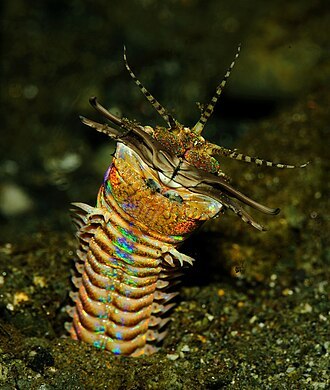
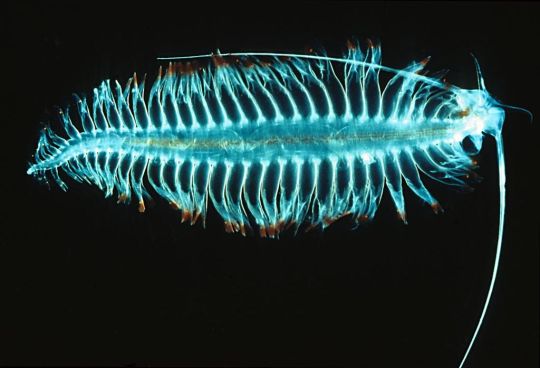
Eunicida. This order of benthic marine worms includes the Bobbit Worm aka the sand-striker
Phyllodocida. This order of marine worms are mostly benthic, but some, like the Gossamer worm, live in the open ocean
#animals#biology#polls#poll tournament#zoology#bobbit worms#worms#annelids#spiralia#Gossamer worms#Eunicida#Phyllodocida#0x7ev0x81#animal tournament#Animal Tournament Round 1
135 notes
·
View notes
Photo

A new species of giant Eunice (Eunicidae, Polychaeta, Annelida) from the east coast of Australia
Joana Zanol, Pat Hutchings
Abstract
A new giant species is described from New South Wales, Australia. Eunice dharastii sp. nov. differs from described Australian species and is most similar to E. aphroditois (Pallas, 1788), E. flavopicta Izuka, 1912, and E. kinbergi Ehlers, 1868.
The unique combination of features that characterizes the new species is irregular articulated prostomial appendages; antennae reaching back beyond chaetiger 4; branchiae starting at chaetiger 10, initially button-shaped and distinctly longer than notopodial cirri where best developed; dorsal fleshy knobs on anterior chaetal lobes; notopodial cirri pendulous, abrupt tapering from inflated bases; bidentate compound falcigerous chaetae with both teeth directed laterally, distal tooth much shorter than proximal tooth in median and posterior chaetigers; and dark bidentate subacicular hooks starting at chaetiger 58, tapering to a small head with both teeth directed distally, and proximal tooth much larger than minute and spur-like distal tooth.
This new species lives in sandy sediments in coastal waters 1–8 m deep. It is highly mobile and not easy to collect, which may explain why it was not described before.
Read the paper here: https://zookeys.pensoft.net/article/86448/
156 notes
·
View notes
Note
Thanks for all the new facts recently! You should do one on bobbit worms... if you're brave enough!
Of course! I've been getting back into the groove of it :D
And of course! I don't see why not, they're cool critters!
Technically speaking, the Bobbit worm is from the order Eunicida of polychaete worms which were first discovered in Norway in the 1700’s. All species in this order have antennae and segmented bodies (parapodia) which can include up to 1500 segments!
Bobbit worms can measure anything from 10cm up to 3m but because they live in the sand and hunt nocturnally, it is unusual to see the entire creature. Their body is covered in bristles and ranges from black or brown through to a purple hue and has an iridescent shimmer to it. They have 5 antennae instead of eyes which they use while hunting.
Like many species of bristle worm, the bobbit worm can also reproduce asexually by splitting into multiple segments, then regenerating body parts such as the head or tail. This enables them to survive being attacked by predators.
#bobbit worm#bobbit worms#fact#facts#animal fact#animal facts#fun animal fact#fun animal facts#fun fact#fun facts#zoology#asks#answered#anonymous#I know its you lobsters#come out come out wherever you are
13 notes
·
View notes
Photo
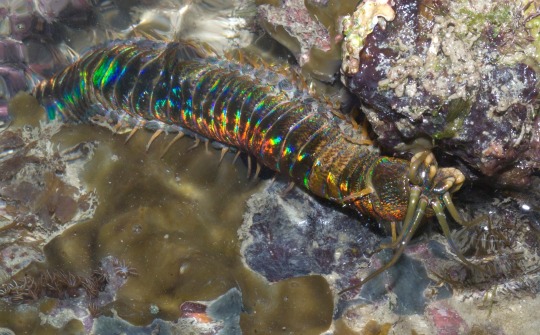
Bobbit worm (Eunice aphroditois)
Photo by Ria Tan
#bobbit worm#bristle worm#eunice aphroditois#eunice#eunicidae#eunicida#errantia#aciculata#polychaeta#annelida#lophotrochozoa
398 notes
·
View notes
Photo
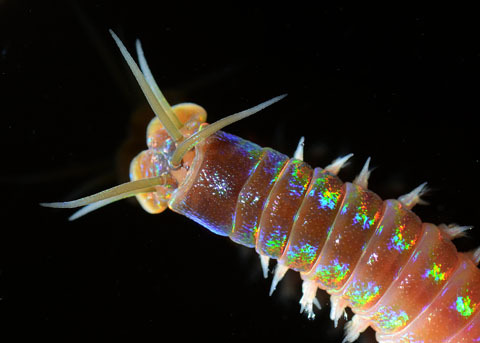
MARINE WORMS ARE EATING MARINE DEBRIS AND CREATING MICROPLASTICS
Buoys of expanded polyestyrene (EPS), are often used in the aquaculture industry, and after time, slowly disintegrate under the influence of sunlight, weather, and animals too. According to a recent study, bristle worms (polychaetes) showed their are eating particles of polyestyrene from buoys, and then excreting microplastics.
Researchers found a lot of EPS particles in the feces of polychaetes from EPS debris, they noted polychaetes burrowed into EPS debris and created numerous EPS microplastic particles, this mean theses organisms are inhabiting marine debris and contributing to microplastic formation.

- Marphysa sanguinea is a common polychaete worm, with two strong black teeth (seen in picture a). This one measures 22 cm, and was collected from EPS buoy debris. EPS particles are clearly seen inside polychaete digestive tract (b), and in feces (c).
According to researchers, polychaetes burrowed into the blocks and created numerous EPS particles, indicating that a single polychaete can produce hundreds of thousand f microplastics particles per year. These finding reveal the potential role of marine organisms as microplastics producers in the marine environments.
Photo of a Marphysa sanguinea by Peter J. Bryant
Reference (Open Access): Jang et al., 2019. Formation of microplastics by polychaetes (Marphysa sanguinea) inhabiting expanded polystyrene marine debris. Marine Pollution Bulletin
#Marphysa sanguinea#polychaete#animals#annelida#Eunicidae#Polychaeta#microplastics#science#marine pollution#plastics#plastic pollution#marine biology#oceans#south korea#pacific ocean#microplastic
134 notes
·
View notes
Photo
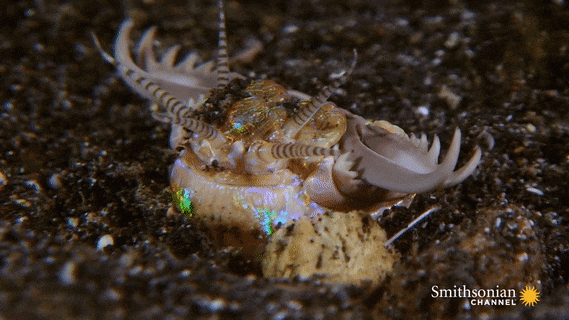
Bobbit Worms are predatory marine worms capable of growing up to 3m. Bobbit attacks can be so vicious they fully bisect their prey. Having no eyes, they catch prey when one of their five antennae are triggered.
(source)
1K notes
·
View notes
Photo
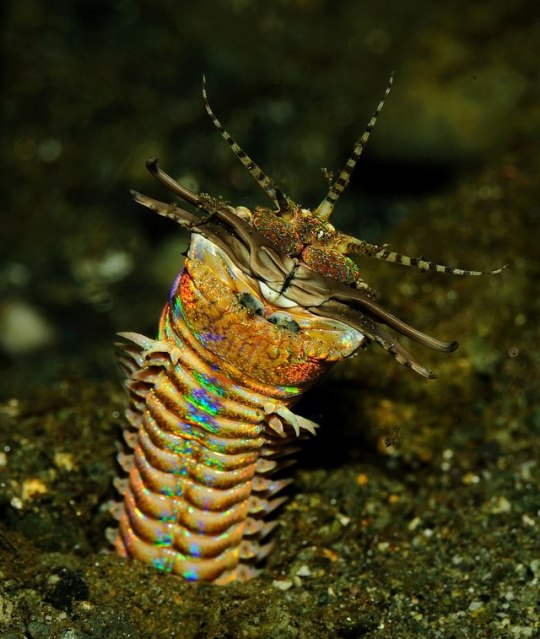
25 notes
·
View notes
Text

SELFIEEEEEEEEE
14 notes
·
View notes
Text
✨Annelida Orders✨
(☟︎all direct tag links☟︎)
(☞︎☞︎☞︎ = Families)
annelida tag
Class Clitellata
Arhynchobdellida
☞︎☞︎☞︎ hirudinidae
Haplotaxida
☞︎☞︎☞︎ glossoscolecidae
Opisthopora
☞︎☞︎☞︎ megascolecidae
Class Polychaeta
Echiuroidea
☞︎☞︎☞︎ urechidae
Eunicida
☞︎☞︎☞︎ eunicidae
Orbiniida
☞︎☞︎☞︎ orbiniidae
Phyllodocida
☞︎☞︎☞︎ nereididae
Sabellida
☞︎☞︎☞︎ sabellidae
2 notes
·
View notes
Text
Taxonomy Tournament: Annelids

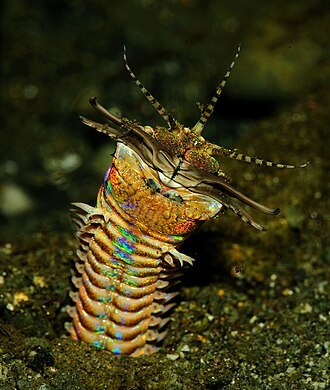
Amphinomida. This order is made up of marine polychaete worms, such as the bearded fireworm
Eunicida. This order of benthic marine worms includes the Bobbit Worm aka the sand-striker
#animals#biology#polls#poll tournament#zoology#bearded fireworms#worms#annelids#spiralia#bobbit worms#Amphinomida#Eunicida#0x1v0x7e
74 notes
·
View notes
Note
So I recently learned about Wormstars where predatory bacteria tangle up the tails of nematodes, creating basically Rat Kings out of them before they eat them from the inside out. Feels ripe for a fakemon
Ooh, that does sound cool! Some worms I’ve been thinking about are
Swima bombiviridis, the Green Bomber. It could easily be made into a part fire type that throws bombs like some kind of cartoon criminal.
Bipalium spp, the hammerhead planarians. I keep envisioning a head like Virizion or a hollow from Bleach.
Terebellidae, the spaghetti worms. The mass of tentacles makes it kind of resemble a gorgon, which reminds me of how Dimetrodone’s gorgon oc Debbie has hair made of worms instead of snakes.
Eunicidae, the bobbit worm and relatives. I already have a bobbit worm, Bobbilisk, but I just think they’re neat. Very robust in shape, and with adorably dopey faces when their pharynxes aren’t everted.
22 notes
·
View notes
Photo
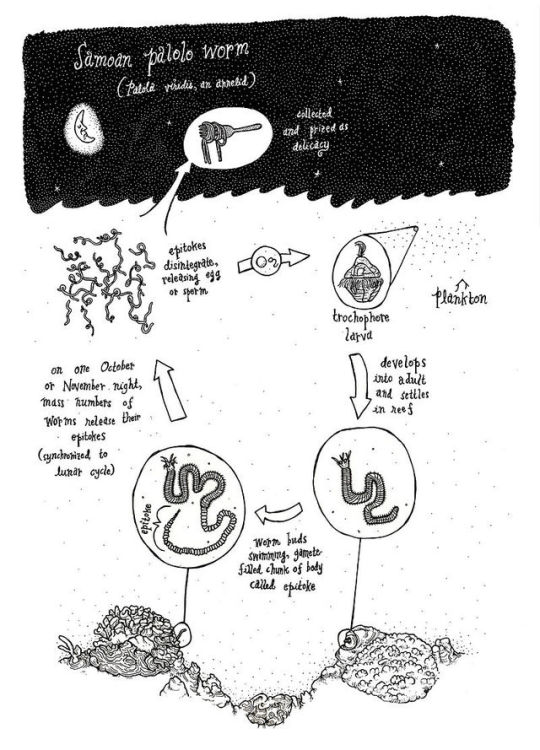
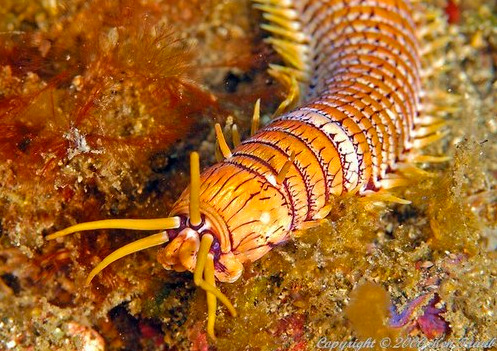
If you are interested in yams, Polynesia, folklore, linguistics, highly-detailed gardening calendars, island ecology, or the sudden simultaneous appearance of hundreds of thousands of sea-worms on a moonlit night, you might enjoy this: Sean P. Connaughton. “A Story of Yams, Worms, and Change from Ancestral Polynesia.” The Journal of Island and Coastal Archaeology Vol. 7 (2012).
Illustration of the Eunicea viridis (Polynesia’s palolo worm) life cycle, above, by Dakuhippo.
To paraphrase this research:
Centuries ago, when Lapita cultures apparently started moving from Melanesia into the western portions of Polynesia centered around Tonga, it seems that horticultural practices, especially regarding the growing of yams, were (like today) extremely important given the distinct dry and wet seasons in the area. Calendars were based on lunar cycles and the lunar months; on some islands, it seems that many individual days of a lunar month could be given a different name to reflect lunar-influenced marine events occurring on that date. So, to mark the best time to start planting yams in order to avoid the dry season, early residents of western Polynesia apparently purposely linked yam season with other ecological events around the same time of year.
The lunar calendar in western Polynesia was augmented with folkloric stories promoting the importance of what were called the palolo months, occurring between September and November. Palolo is a local name for giant polycheate sea-worms, especially Eunicea viridis, closely-related to and of the same genus as the famous predatory Bobbit worm. These months included the seasonal rising of reproductive segments of the annelid sea-worm of the Eunicidae family in certain nearby ocean areas. In other words, there is a massive Worm Event(TM) where a bunch of spaghetti-like worms rise to the surface in giant masses.
The arrival of the worms marked a definitive climatic shift from dry to wet season, and therefore marked the arrival of yam-growing season. By observing the worms’ behavior, island residents could accurately anticipate the most successful times for food cultivation. The worm event was, and still is, mostly limited to Tonga, Samoa, and parts of far western Polynesia, where the earlier Polynesian voyages originated; the seasonal worm event apparently does not occur across most of Polynesia, especially east of Tonga and Samoa.
However, even though the worms are absent in, say, Tahiti, the lunar calendars of Polynesians living in Tahiti and other locations far to the east of Tonga still include references to the palolo months. So, essentially, the horticultural activity surrounding yam-growing season was so important in western Polynesia that the sea-worm event itself also became an important part of the western Polynesia lunar calendar; the yams and the worms became so intertwined that, as Polynesian people later migrated much farther eastward towards Tahiti, the worm references still appear in language and calendars of communities living thousands of kilometers away, and in calendars that today still exist a few centuries later in history.

In Tonga, Samoa, and nearby islands, the annual arrival of palolo worms is still a big event. (Palolo worm harvest also happens in parts of Indonesia.)
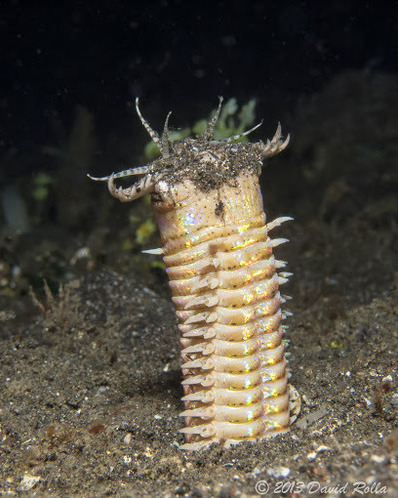
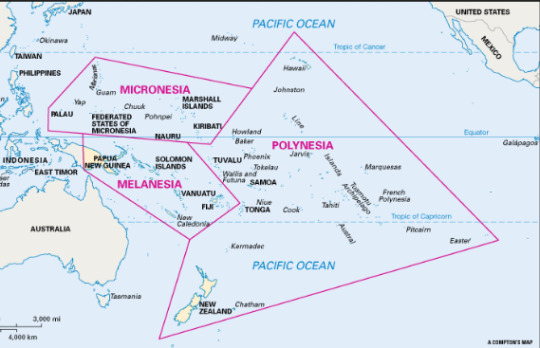
-
Just some fun details about what some people call: “the yam calendar.”
78 notes
·
View notes
Text

TALK ABOUT: Voice Actor #Subaru Kimura is here discussing song project Hypnosis Mic 📻
They’re also talking about their shared experience of being a student council president😯

But while he was taking the National Center Test for Admission...
#Subaru Kimura-san put so much effort into his high school entrance test that he fainted...
~
Taiki: Me & @richpotatoboya [Kimura], the vocalist of Ichiro Yamada in Hypnosis Mic Buster Bros!!!
He’s amazing
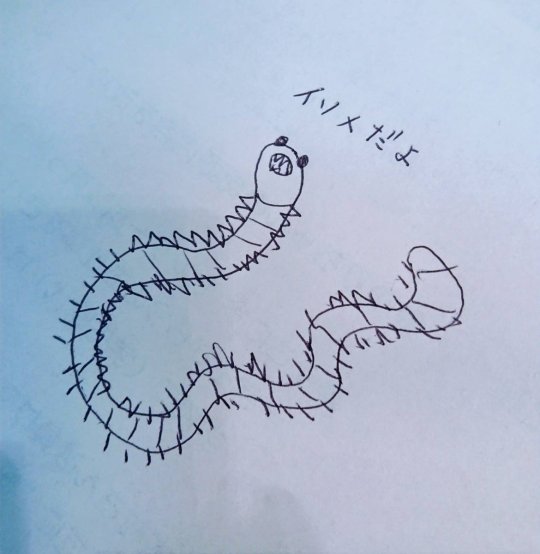
TALK ABOUT: Fishing bait which Taiki Kudo drew, called “Eunicida”、、、🤔

Enka singer # Yuuki Tokunaga will releasing【 Enka no Miryoku 🎤】
Hip hop in the first half, enka in the second half
Let’s #TALK ABOUT that level of variety 👊
~
Taiki: @Tokuchan1113, Yuuki Tokunaga-kun
Here for an enka special feature
He’s also amazing
Next time, let’s do a special feature with him about the railway system! lol

TALK ABOUT: NEXT WEEK’s Corner
We’re taking your calls right now ☎ ️
# Talk About
5 notes
·
View notes
Photo
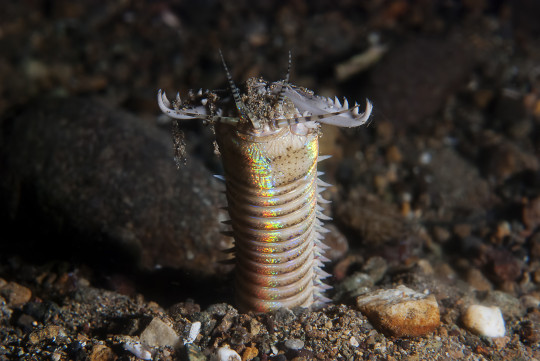
Bobbit worm (Eunice aphroditois)
Photo by Arne Kuilman
#bobbit worm#bristle worm#eunice aphroditois#eunice#eunicidae#eunicida#errantia#aciculata#polychaeta#annelida#lophotrochozoa
24 notes
·
View notes